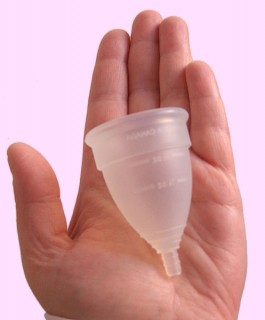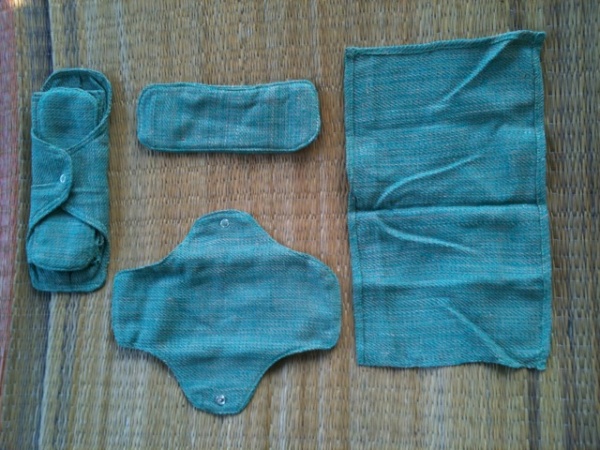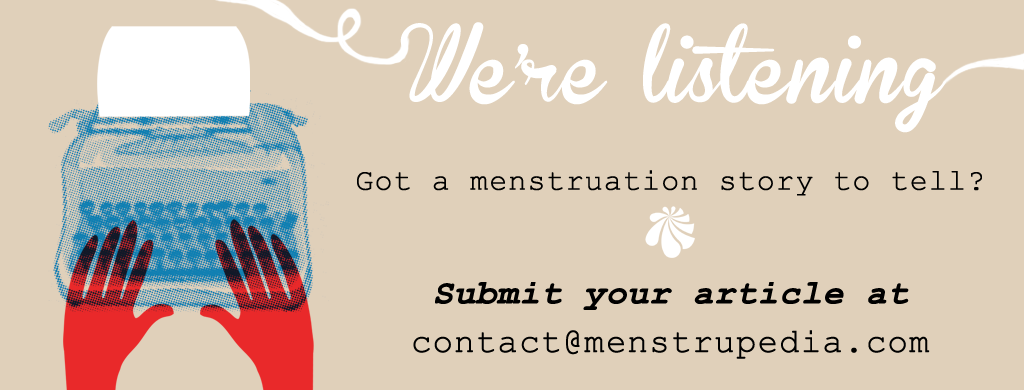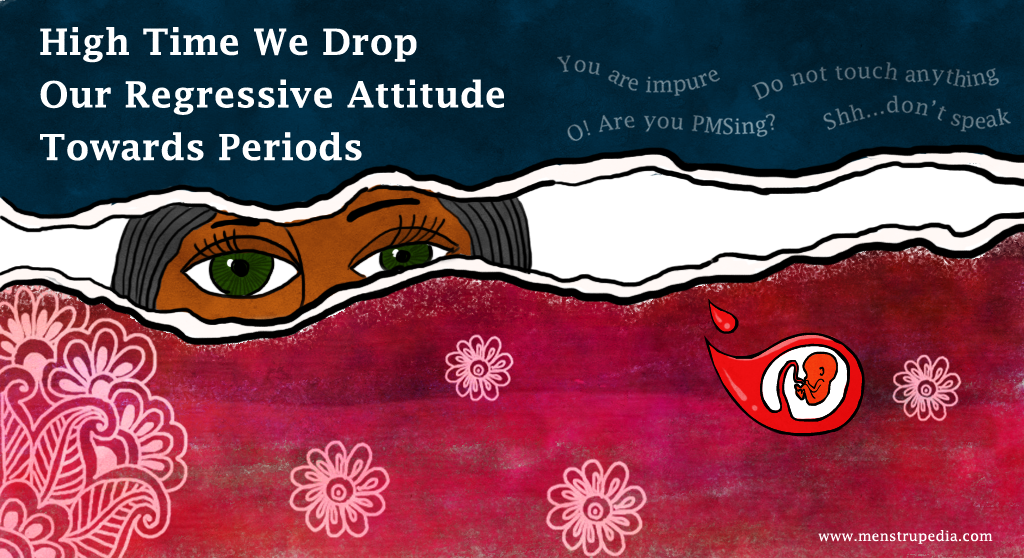This article attempts to answer many frequently asked questions related to eco-friendly menstruation options. Menstrual cups and cloth pads are the two major options that are available in the Indian market; hence I will discuss both of them here in detail.
1. Menstrual cups

Although a relatively new concept in India, the menstrual cup is slowly gaining popularity now. It is basically a ‘cup’ shaped reservoir made of medical grade silicon that collects the blood when kept inserted inside the vagina.
History
Although there have been several versions of menstrual cups produced since 1930s, KeeperCup is said to be one of the first modern menstrual cups, which was made of rubber. But all the other modern menstrual cups are now made of silicon.
The Hygiene Factor
The blood collected by the menstrual cup stays inside the vagina, and doesn’t come in contact with outside air. Owing to this, menstrual cups are more hygienic than any other alternative. Moreover, there’s no foul smell of the blood, rashes or itchiness which are commonly linked to the use of disposable pads.
The Convenience Factor
Remember the advertisements of disposable sanitary napkin companies showing ladies feeling a sense of freedom on using their product? Once you have used menstrual cups, you will realize what true freedom is. I have had some of my best holidays – getting totally drenched in waterfalls and beaches, etc. – during those first three dreadful days, all thanks to SheCup! As it easily goes for 10 hours (or even 12 hours) without emptying the cup, at times I have simply forgotten about periods, and needed to set an alarm to empty the cup! In short, convenience is a massive advantage offered by menstrual cups. For the first time users, here is a large discussion forum on menstrual cup users!
Ease of Use
It’s easier to operate the cup than most people imagine. I took one menstrual cycle to master the usage, and used nappy liners in that cycle to avoid any leakages. One just has to show a little bit of patience early on to master the trick of inserting and getting out the cup. Once you learn it, it gets pretty easy from the next time onward. When I bought Diva Cup first, I was travelling most of the months, and I used it even in the moving train on multiple occasions! There are some good resources available online about tips and tricks of using menstrual cups.
Brands
SheCup is the only Indian brand available in the market. There are other brands such as Lunette, MoonCup, DivaCup, KeeperCup, etc. KeeperCup is made from rubber and might pose the risk of latex allergies to certain women. Other cups are made out of medical grade silicon, which is pretty safe. Most of these cups are available in two sizes. Here is a very good comparisons of all the major brands.
The Sustainability Quotient
Assuming that you menstruate approximately 350 times in your lifetime, using 20 disposables pads during each cycle, you end up throwing 7000 disposable pads in the landfills. And that’s just for one woman. If you consider number of women in the world using these disposable pads, the total number would be humongous! Moreover, there’s also the ecological footprint stemming from packaging, manufacturing, etc. In contrast, menstrual cups last for about 2 years, doing away with all this wastage/environmental damage.
Taboos: In India menstrual cups are not much famous as many women are hesitant about touching vaginal blood which is generally considered to be dirty blood. Actually, menstrual blood is secreted so that the egg can come out every 28 days from the ovary. There’s absolutely nothing dirty in this blood! Some women I have talked to are not comfortable with the idea of inserting something inside their vagina. (Tampons too aren’t used much because of the same reason). I believe it’s high time we shed these inhibitions about something that is hygienic, cost-effective and so very convenient!
Menstrual Cups and TSS
Toxic Shock Syndrome risk is generally associated with the usage of tampons, as they dry out vaginal fluid while absorbing the blood. Menstrual cups merely collect the blood, hence no TSS risk is associated with their continual usage.
How Much Does it Cost?
Indian brand SheCup costs around Rs. 695, and the company claims that it can last till 2 years. Considering 1.5 years as the average life span, one can easily recover this cost just within 2-3 months. Other brands cost a little higher but in the long run they are still cheaper than disposable sanitary napkins.
2. Reusable cloth pads

They are one of the oldest options w.r.t. menstrual products. I have used a slightly unsophisticated version of them during my teens, when disposable pads were not too common. The modern cloth pads, however, are much easy to use and more efficient too. They come in various sizes and designs, and can easily be cleaned after usage.
The Hygiene Factor
Since they are made of soft cotton fabric (in most cases organic cotton), they are safer than disposable pads and do not cause any skin irritations that occur because of chemicals in the disposable pads.
In India, EcoFemme so far is the makes cloth pads that are readily available everywhere on order. Folks at Srikakulam chapter of Association of India’s Development (AID), makes reasonably low cost menstrual cloth pads (Rs. 50/- per set). They can be ordered by sending an email to [email protected].
Goonj has an initiative called NJPC (Not just a piece of cloth) through which they make menstrual pads out of old clothes and make them available to rural women. However, I have not come across anyone who has used it firsthand.
The Cost Factor
Cloth pads available in Indian market may seem costly, but they are much cheaper than disposable pads in the long run. They are also cheaper than menstrual cups.
Make Your Own Cloth Pad
If you are hands on with the sewing machine, making a cloth pad might be even cheaper. One could also make it more eco-friendly by using material from old clothes. Here is one of the many resources available online for this.
Ease of Use
Cloth pads can be used just the way disposable pads are. The modern pads are also easier in washing. All you need to do is soak it in the warm water so that blood leaves the cloth, and wash it using regular cloth washing methods.
The Sustainability Factor
All the sustainability arguments that are made in favour of menstrual cups can also be applied here. Cloth pads can be even more sustainable if made at home by re-using old material. They might lead to more water consumption in terms of washing/cleaning in comparison to menstrual cups.
Growing Advocates of Eco-Friendly Menstruation
During the last few months I have received a number of emails from ladies who have made the switch to menstrual cups or cloth pads. My sister-in-law Ruchi who started using cloth pads from eco-femme finds them pretty convenient to use. “I wouldn’t have thought of going back to old ways of using a cloth for this purpose had it not been for Ecofemme.” she told me after using it for a few months.
Parul Gupta, co-founder of SlideRule emails me after using the cup for 6+ months, “The idea sounded gruesome but also compelling because we are well aware of the vast amounts of non-degradable waste STs create. I forced myself to try it and to my surprise it worked beautifully. Now I have been using it for >6 months not only because it is environment friendly, but also because it is so much more convenient.”
A few girls who started using the cup found it difficult to get it out in the initial days. I asked them to hang in there for another month and later I received their messages saying they are now finding it pretty easy to work with!
Any change of significance is difficult in the beginning, but the huge long-lasting gains far outweigh any discomfort faced initially. Plus, once we get the hang of the operational tricks, using both the cup as well as the reusable cloth pad is actually no harder than putting on a disposable pad. So, my suggestion to all the ladies reading this is to just go have a stab at one of these two options. Once you have given them a go for at least one cycle, I am fairly confident that you will be hooked to them for good.
 Author: Sejal Parikh
Author: Sejal Parikh
A Telecommunication engineer by profession, who used to work with MNCs until she found her interests venturing into environmental and social problems. She’s now a passionate vegan, freelance writer at the same time trying her best to be a green momma :-). She blogs at Sejswhirlpool
Originally published on “The Alternative“








